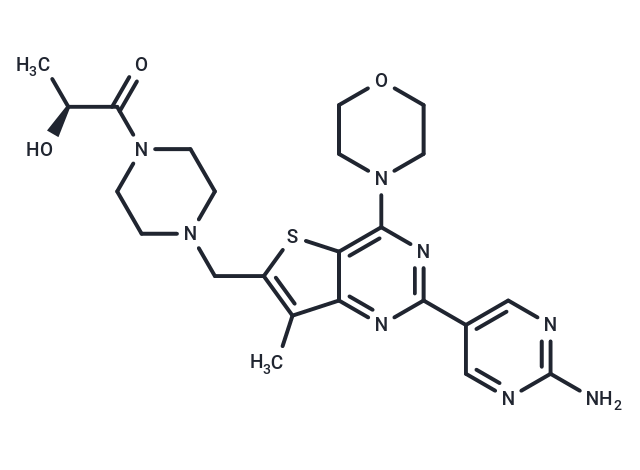购物车
- 全部删除
 您的购物车当前为空
您的购物车当前为空

Apitolisib (RG 7422) 是一种口服有效的 PI3K 和 mTOR(TORC1/2) 激酶抑制剂,抑制 PI3Kα/PI3Kβ/PI3Kδ/PI3Kγ的活性,IC50值为 5 nM/27 nM/7 nM/14 nM,抑制 mTOR,Ki 为 17 nM。它用于乳腺癌、前列腺癌、肾细胞癌和子宫内膜癌等实体癌的试验研究 。


为众多的药物研发团队赋能,
让新药发现更简单!
Apitolisib (RG 7422) 是一种口服有效的 PI3K 和 mTOR(TORC1/2) 激酶抑制剂,抑制 PI3Kα/PI3Kβ/PI3Kδ/PI3Kγ的活性,IC50值为 5 nM/27 nM/7 nM/14 nM,抑制 mTOR,Ki 为 17 nM。它用于乳腺癌、前列腺癌、肾细胞癌和子宫内膜癌等实体癌的试验研究 。
| 规格 | 价格 | 库存 | 数量 |
|---|---|---|---|
| 1 mg | ¥ 359 | 现货 | |
| 2 mg | ¥ 517 | 现货 | |
| 5 mg | ¥ 913 | 现货 | |
| 10 mg | ¥ 1,330 | 现货 | |
| 25 mg | ¥ 2,370 | 现货 | |
| 50 mg | ¥ 3,820 | 现货 | |
| 100 mg | ¥ 5,520 | 现货 | |
| 500 mg | ¥ 11,300 | 现货 |
| 产品描述 | Apitolisib (RG 7422), an effective, class I PI3K inhibitor for PI3Kα(IC50=5 nM), PI3Kβ(IC50=27 nM), PI3Kδ(IC50=7 nM), PI3Kγ (IC50=14 nM), is used in trials study of solid cancers, breast cancer, prostate cancer, renal cell carcinoma, and endometrial carcinoma, among others. |
| 靶点活性 | p110δ:7 nM, p110γ:14 nM, p110α:5 nM |
| 体外活性 | 在PC-3和MCF-7 neo/HER2异种移植模型中,GDC-0980(1 mg/kg)能够抑制肿瘤生长.在小鼠中,静脉给药 GDC-0980(1 mg/kg). |
| 体内活性 | 在PC3(IC50=307 nM)和MCF7细胞(IC50=255 nM)中,GDC-0980明显抑制的细胞增殖。对于I类PI3K和mTOR激酶,GDC-0980的选择性抑制作用显著,对mTOR的(Ki=17 nM),对于PI3Kα(IC50=5 nM),β(IC50=27 nM),δ(IC50=7 nM),和γ(IC50=14 nM)。 |
| 激酶实验 | Enzymatic activity: Enzymatic activity of the Class I PI3K isoforms is measured using a fluorescence polarization assay that monitors formation of the product 3,4,5-inositoltriphosphate molecule as it competes with fluorescently labeled PIP3 for binding to the GRP-1 pleckstrin homology domain protein. An increase in phosphatidyl inositide-3-phosphate product results in a decrease in fluorescence polarization signal as the labeled fluorophore is displaced from the GRP-1 protein binding site. Class I PI3K isoforms are expressed and purified as heterodimeric recombinant proteins. PI3K isoforms are assayed under initial rate conditions in the presence of 10 mM Tris (pH 7.5), 25 μM ATP, 9.75 μM PIP2, 5% glycerol, 4 mM MgCl2, 50 mM NaCl, 0.05% (v/v) Chaps, 1 mM dithiothreitol, 2% (v/v) DMSO at the following concentrations for each isoform: PI3Kα,β at 60 ng/mL; PI3Kγ at 8 ng/mL; PI3Kδ at 45 ng/mL. After assay for 30 minutes at 25°C, reactions are terminated with a final concentration of 9 mM EDTA, 4.5 nM TAMRA-PIP3, and 4.2 μg/mL GRP-1 detector protein before reading fluorescence polarization on an Envision plate reader. IC50s are calculated from the fit of the dose?response curves to a 4-parameter equation.Human recombinant mTOR(1360?2549) is expressed and purified from insect cells and assayed using a Lanthascreen fluorescence resonance energy transfer format in which phosphorylation of recombinant green fluorescent protein (GFP)-4-EBP1 is detected using a terbium-labeled antibody to phospho-threonine 37/46 of 4-EBP1. Reactions are initiated with ATP and conducted in the presence of 50 mM Hepes (pH 7.5), 0.25 nM mTOR, 400 nM GFP-4E-BP1, 8 μM ATP, 0.01% (v/v) Tween 20, 10 mM MnCl2, 1 mM EGTA, 1 mM dithiothreitol, and 1% (v/v) DMSO. Assays are conducted under initial rate conditions at room temperature for 30 minutes before terminating the reaction and detecting product in the presence of 2 nM Tb-anti-p4E-BP1 antibody and 10 mM EDTA.Dose?response curves are fit to an equation for competitive tight-binding inhibition and apparent Ki' s are calculated using the determined Km for ATP of 6.1 μM. |
| 细胞实验 | Antiproliferative cellular assays are conducted using PC3 and MCF7.1 human tumor cell lines. MCF7.1 is an in vivo selected line and originally derived from the parental human MCF7 breast cancer cell line. Cell lines are cultured in RPMI supplemented with 10% fetal bovine serum, 100 units/mL penicillin, and 100 μg/mL streptomycin, 10 mM HEPES, and 2 mM glutamine at 3°C under 5% CO2. MCF7.1 cells or PC3 cells are seeded in 384-well plates in media at 1000 cells/well or 3000 cells/well, respectively, and incubated overnight prior to the addition of GDC-0980 to a final DMSO concentration of 0.5% v/v. MCF7.1 cells and PC3 cells are incubated for 3 days and 4 days, respectively, prior to the addition of CellTiter-Glo reagen and reading of luminescence using an Analyst plate reader. For antiproliferative assays, a cytostatic agent such as aphidicolin and a cytotoxic agent such as staurosporine are included as controls. Dose?response curves are fit to a 4-parameter equation and relative IC50s are calculated using Assay Explorer software.(Only for Reference) |
| 别名 | RG 7422, GNE 390, GDC-0980 |
| 分子量 | 498.6 |
| 分子式 | C23H30N8O3S |
| CAS No. | 1032754-93-0 |
| Smiles | C[C@H](O)C(=O)N1CCN(Cc2sc3c(nc(nc3c2C)-c2cnc(N)nc2)N2CCOCC2)CC1 |
| 密度 | 1.399 g/cm3 |
| 存储 | Powder: -20°C for 3 years | In solvent: -80°C for 1 year | Shipping with blue ice. | ||||||||||||||||||||
| 溶解度信息 | Ethanol: < 1 mg/mL (insoluble or slightly soluble) DMSO: 4.99 mg/mL (10 mM), Sonication is recommended. H2O: < 1 mg/mL (insoluble or slightly soluble) | ||||||||||||||||||||
溶液配制表 | |||||||||||||||||||||
DMSO
| |||||||||||||||||||||
评论内容